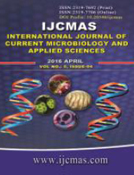


 National Academy of Agricultural Sciences (NAAS)
National Academy of Agricultural Sciences (NAAS)

|
PRINT ISSN : 2319-7692
Online ISSN : 2319-7706 Issues : 12 per year Publisher : Excellent Publishers Email : editorijcmas@gmail.com / submit@ijcmas.com Editor-in-chief: Dr.M.Prakash Index Copernicus ICV 2018: 95.39 NAAS RATING 2020: 5.38 |
Polyhydroxybutyrate (PHB), a product of microbial metabolism, is the most commonly known biodegradable polymer that has emerged as an alternative to conventional synthetic and non biodegradable plastic. Traditionally PHB producers have been isolated from various sources like soil, marine environment, sewage, sludge, industrial effluent, etc. The present study was aimed at isolating PHB producing bacteria from varied plant based sources. Using Nile Blue A as a primary qualitative screening method, 11 probable PHB positive bacteria were isolated and then evaluated for their PHB producing ability employing a conventional analytical method based on UV-spectrophotometric quantitation. The yields obtained were between 63-172 mg /L. Further characterization of PHB production was done using a less explored but powerful technique of flow cytometry. The flow cytometry revealed considerable variation in the PHB biosynthesis in the selected time range by the different isolates. The two different screening tools used to assess PHB accumulation confirmed the PHB producing ability of the isolates. The work presented shows that plant sources can be novel and promising sources for PHB isolation and hence should be explored more in future for isolation of diverse microflora.
 |
 |
 |
 |
 |